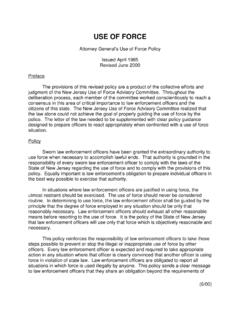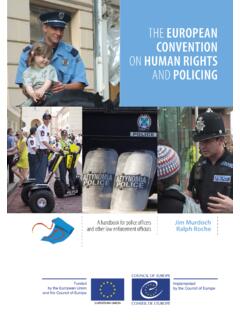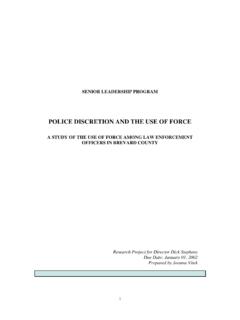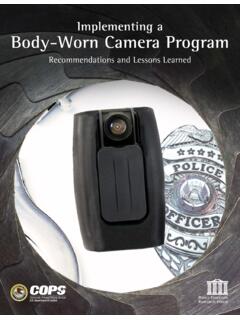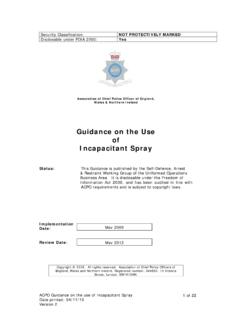Transcription of Police Officers' Decision Making and Discretion
1 The author(s) shown below used Federal funds provided by the Department of Justice and prepared the following final report: Document Title: Police Officers' Decision Making and Discretion : Forming Suspicion and Making a Stop Author(s): Geoffrey P. Alpert Roger G. Dunham Meghan Stroshine Katherine Bennett John MacDonald Document No.: 213004 Date Received: February 2006 Award Number: 2001-IJ-CX-0035 This report has not been published by the Department of Justice.
2 To provide better customer service, NCJRS has made this Federally-funded grant final report available electronically in addition to traditional paper copies. Opinions or points of view expressed are those of the author(s) and do not necessarily reflect the official position or policies of the Department of Justice. Police Officers' Decision Making and Discretion : Forming Suspicion and Making a Stop A Report to The National Institute of Justice Geoffrey P. Alpert University of South Carolina Roger G. Dunham University of Miami Meghan Stroshine Marquette University Katherine Bennett Armstrong Atlantic State University John MacDonald RAND October 2004 I This research was supported National Institute of Justice Grant 2001 -1J-CX-0035, Office of Justice Programs, Department of Justice.
3 Points of view in this report are those of the authors and do not necessarily represent the official position or policies of the I Department of Justice. This document is a research report submitted to the Department of Justice. This report has not been published by the Department. Opinions or points of view expressed are those of the author(s) and do not necessarily reflect the official position or policies of the Department of Justice. Police Officers Decision Making and Discretion : Forming Suspicion and Making a Stop Table of Contents Abstract Executive Summary 1. Introduction 2. Site Description and Methodology 3. Data Analysis Precinct-Level Analyses 4.
4 Conclusions and Policy Implications Appendix A: Data Collection Forms This document is a research report submitted to the Department of Justice. This report has not been published by the Department. Opinions or points of view expressed are those of the author(s) and do not necessarily reflect the official position or policies of the Department of Justice. Police Officers Decision Making and Discretion : Forming Suspicion and Making a Stop Abstract Most Police activity occurs in private, away from the public=s view. This creates a situation that allows Police officers Discretion in the way they think about what they see and how they handle those with whom they come in contact.
5 There has been an effort by the research community to examine issues concerning how Police act and respond in general and what Police do specifically when they interact with citizens. A conspicuous void in the research effort has been the lack of attention paid to the process by which Police officers form suspicion about a suspect whether or not a formal intervention such as a stop was made. Officers in Savannah, Georgia were observed and debriefed after they became suspicious about an individual or vehicle. Observers accompanied officers on 132, 8-hour shifts, during which time, the officers formed suspicion 174 times. AForming suspicion@ occurred any time an officer became doubting, distrustful or otherwise troubled or concerned about an individual.
6 In most of the cases, it was the behavior of the suspect(s) that concerned the officer. This concern did not always result in a stop of an individual or vehicle. In some cases, the officers realized that their initial Asuspicion@ was unsupported. In fact, 103 stops resulted from the suspicions that were formed by the officers during the times they were observed. Several factors were significantly associated with the likelihood that an officer would make a stop based on suspicion. Interestingly, none of the characteristics of the suspect was important. In other words, officers were equally likely to stop individuals whether they were male or female, African-American or white, low or high socioeconomic status.
7 I This document is a research report submitted to the Department of Justice. This report has not been published by the Department. Opinions or points of view expressed are those of the author(s) and do not necessarily reflect the official position or policies of the Department of Justice. The encounters were assessed by the interactions between the officers and suspects. Although most encounters went smoothly, some changed character based on the actions and attitudes of one or both of the actors. ii This document is a research report submitted to the Department of Justice. This report has not been published by the Department. Opinions or points of view expressed are those of the author(s) and do not necessarily reflect the official position or policies of the Department of Justice.
8 Police Officers Decision Making and Discretion : Forming Suspicion and Making a Stop Executive Summary The majority of past research on Police behavior has employed observational methodology to focus on actions taken by officers following contact with a citizen. This past research has largely concentrated on whether or not an arrest or other formal intervention follows a stop or other Police -citizen interaction. The research at hand examines Police officers decisions before an initial contact is made. This study therefore focuses on the formation of suspicion and the Decision to stop and question a citizen. Additionally, we analyze the outcomes of these stops.
9 It is important to note that observational studies have generally been designed to collect information on the actions and reactions of the Police and citizens during an encounter, and that the common limitation of such studies lies in an assessment that focuses on the interaction process after the contact with a citizen has been made. While this method does produce data capable of answering many important questions about Police behavior, it does not address why an officer selects a particular individual for a stop, thereby transforming some citizens into suspects at the expense of other citizens who are ignored. Our research, therefore, focuses on the vitally important decisions made prior to an initial Police -citizen contact, answering questions about forming suspicion and Making the Decision to stop a citizen.
10 These observations, read in conjunction with the outcome of these stops, provide a useful insight into how the Decision to make a stop can affect Police -citizen interactions. Methodology 1 This document is a research report submitted to the Department of Justice. This report has not been published by the Department. Opinions or points of view expressed are those of the author(s) and do not necessarily reflect the official position or policies of the Department of Justice. The present endeavor attempts to fill some of the gaps in the previous research. Our methodology integrates quantitative and qualitative data collection in an effort to improve the value of the data.










